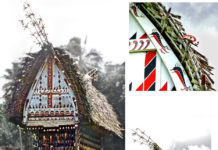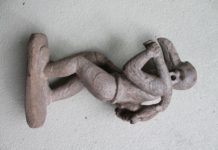Wood carving is widespread in Kazakhstan as a traditional craft. The yurt’s frame is entirely made of wood, including the shanyrakh (cylindrical top part), uykh (poles that are embedded in the shanyrakh and fixed to keregeh, or greedwall) and sykhyrlauikh (doors). The internal furniture is made of wood as well. including abdireh or sandykh (chests), tosekaghash or keruet (bed), besyk (cradle), assadal (buffet), kebezheh (kitchen cabinet) and dastarkhan (low table). Kitchenware is partly made of wood, including kubyi (butter making jar), tegeneh (cups for kumis, fermented mare’s milk), ozhau (ladle), tostaghan (bowls), saptiyayak (water dippers), astau (bastau, a large plate for boiled meat) and tabakh (plate). As well, special wooden stands (zhukh ayakh) are carved for protection against humidity. Wood carving is also used for production of musical instruments, souvenirs and horse-saddles (yer).
 In forest-rich Eastern and Northern Kazakhstan, hardwood trees are used for carving, including red birch, maple, black or red alder, ash, nut tree, and oak. In Southern Kazakhstan, trees like elm, nut tree, pear, acacia, elaeagnus (djygyda), plane tree (chinara) are used for carving. As well, tree roots and knots are used. In South-East of Kazakhstan, elm, apple, nut tree, and buckthorn are usually used by woodcarvers. Table and chair legs, and some yurt parts are usually carved from pine, aspen or poplar. Other hardwood used for carving includes mulberry tree, and in softwood, juniper.
In forest-rich Eastern and Northern Kazakhstan, hardwood trees are used for carving, including red birch, maple, black or red alder, ash, nut tree, and oak. In Southern Kazakhstan, trees like elm, nut tree, pear, acacia, elaeagnus (djygyda), plane tree (chinara) are used for carving. As well, tree roots and knots are used. In South-East of Kazakhstan, elm, apple, nut tree, and buckthorn are usually used by woodcarvers. Table and chair legs, and some yurt parts are usually carved from pine, aspen or poplar. Other hardwood used for carving includes mulberry tree, and in softwood, juniper.
Every wood carved product is decorated with ornament. Pattern and design of wood carved objects are also based on the balance of foreground and background, vertical symmetry, importance of central piece and border pattern. Traditional woodcarving includes several techniques and cuts, such as contour, relief and three-sided hollow carving. Relief carving is used for decorating chests, cabinets, doors, beds and kitchenware. Painted relief carving is used for decorating yurt doors and buildings of worship. Three-sided hollow craving is used for making geometric patterns. Cutout is mostly used for floral ornaments. To make dishes water resistant, they are soaked with boiled animal fat.
Carved objects can be combined with paintings. Usually the background is unpainted, while the foreground is painted red, blue, green and yellow. Objects can also be decorated with inlaid bones, silver and other metals. Metallic details can be decorated with precious and semi-precious stones.
Modern artisans/artists include Zh. Turdygulov, T. Begymbet, Naga Imanbayev family, Zh. Makhambet, Ya. Auyelbekob, S. Saliyev, Ye. Askarov, S. Kokenov, A. Mukhazhanov, B. Atamkulov, A. Moldakhanov, F. Kamalov, S. Nazarkhanuly, A. Orazghaly, N. Kaliyev, N. Orynbassarov, B. Moldabekov, M. Zhapabayev, D. Mynsharipov, N. Zhakibayev and Black Ltd.





